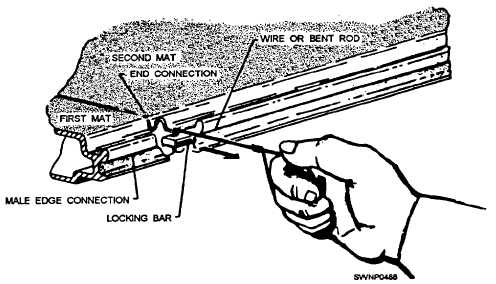
Figure 11-36. - Removal of locking bar.
6. With the clearance now provided, removal of the remainder of the matting and additional guide rail, as necessary to affect the repair, may be readily accomplished Remove the cut piece of guide rail aft of the repair area by removing locking bars and disconnecting the guide rail pins, using a pin remover, NAEC Part No. 414223-1. Slide the guide rail out of the mats.
7. Repair the ground surface, as necessary, before installing the guide rail and new or refurbished matting.
8. The installation procedure must be the same as that for the original installation. Replace the locking bars.
9. Reinstall matting over the repair area until the last row of matting is in place. At this point, this row of matting must be raised in unison with pry bars to permit installation of locking bars.
NOTE: It will not be possible to insert locking bars between the guide rail and adjacent mats for this row. Therefore, a replacement mat should be installed next to the guide rail. A locking bar is built into the replacement mat.
10. Insert the typical keylocks in the reverse order in which they were taken out. Always use wood blocking between the hammer and connector if force is necessary to drive the sections into place.
Excessive mat deflection and roughness, which can be attributed to cavities under the mats, can be repaired in the following manner:
1. Remove all mats that show excessive wear and deformation according to the instructions given earlier.
2. Fill all cavities under the mats and cover cavity areas with old matting. Areas should be reinforced with any available matting: M9M1, M9M2, AM-1, or damaged AM-2 mats. The mats in the bottom layer need not be joined together to save material and manpower. It is advisable to have the reinforcing mats touching, but it is not imperative that the mats in the bottom layer be interlocked. The mats in the bottom layer must be placed with the long dimension of the mats at right angles to the mats in the top layer. A double layer of matting should be considered in all cases where sandy areas can cause excessive mat roughness due to movement of the sand
3. Replace the top layer of matting according to the instructions given earlier.
Before proceeding, note that a heavy-duty mat, as shown in figure 11-37, has been developed

Figure 11-37. - Heavy-duty mat.
Continue Reading